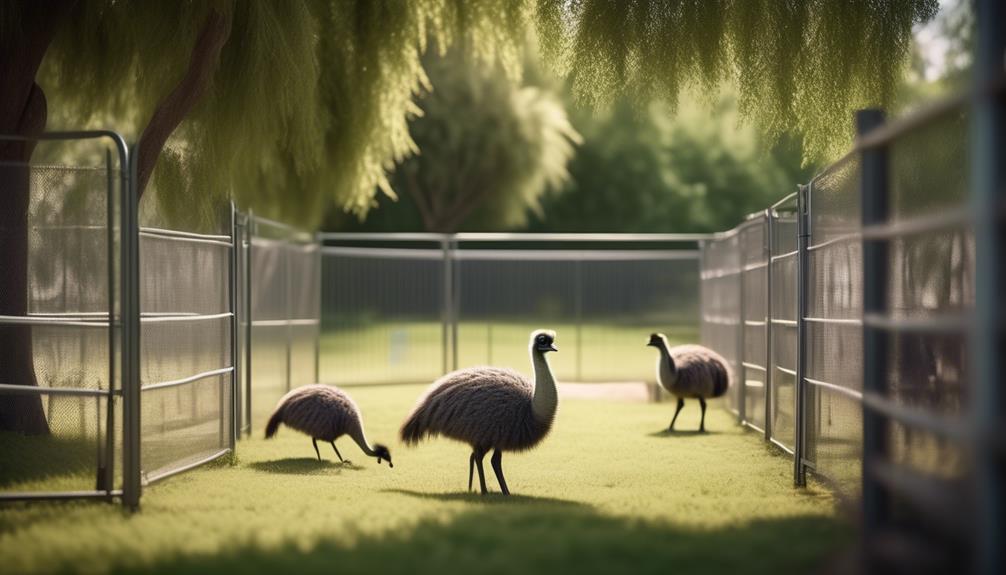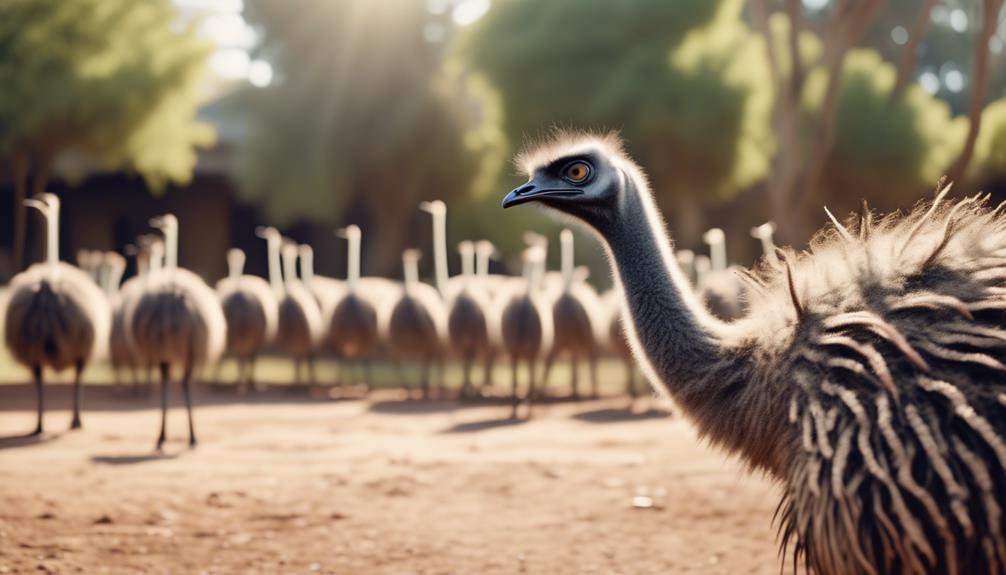
So, you've decided to expand your emu flock and bring in some new members. Let's say you recently acquired a young emu from a reputable breeder and you're eager to introduce it to your existing flock.
But how do you go about this process to ensure a smooth integration and minimize any potential conflicts? Well, fear not, because in this discussion, we will explore the best practices for introducing new emus to your flock.
By following these guidelines, you'll be equipped with the knowledge and strategies to successfully introduce new emus and create a harmonious environment for your feathered friends.
Key Takeaways
- Implement a rigorous quarantine period and conduct thorough health checks before introducing new emus to the flock to prevent the spread of diseases.
- Provide a suitable introduction space with visual contact between new and existing emus, multiple feeding and watering stations, and supervised group interactions or free-ranging.
- Gradually introduce emus during feeding time and increase the duration and frequency of interaction sessions to ensure a smooth socialization process.
- Monitor individual interactions, group dynamics, and address any conflicts or aggression promptly to maintain a harmonious flock.
Assessing Your Current Flock

To accurately assess your current flock of emus, carefully observe their behavior, health, and overall condition. Evaluating compatibility is crucial before introducing new emus.
Begin by observing their interactions within the flock. Are they friendly and social, or do they exhibit signs of aggression? Emus are naturally curious and social birds, so a harmonious flock will display peaceful behavior. Take note of any emu that seems isolated or excessively submissive, as this could indicate compatibility issues.
Next, closely monitor the health of your emus. Are they active, alert, and displaying good appetite? Any signs of lethargy, weight loss, or abnormal behavior should be addressed promptly. Ensure that each emu is receiving proper nutrition and preventive healthcare to maintain their overall well-being.
When assessing the overall condition of your flock, consider the size of your enclosure. Is it spacious enough to accommodate more emus? Emus require ample room to roam, so overcrowding can lead to stress and territorial disputes. Additionally, assess the availability of resources such as food, water, and shelter. Ensure that each emu has access to these essentials to foster a healthy and balanced flock dynamics.
Quarantine and Health Checks
Before introducing new emus to your flock, it's essential to implement a rigorous quarantine period and conduct thorough health checks. These quarantine procedures are crucial for the health and well-being of your existing flock. Quarantine should last for a minimum of 30 days, allowing sufficient time to identify any potential diseases or parasites. During this period, the new emus should be kept in a separate enclosure, away from the existing flock.
To ensure a smooth transition and prevent the spread of diseases, it's important to follow flock health protocols. This involves conducting thorough health checks on the new emus before introducing them to the flock. A veterinarian should perform a physical examination of each new emu, checking for signs of illness, such as respiratory issues or abnormal feces. Additionally, a fecal examination should be conducted to check for internal parasites.
Providing a Suitable Introduction Space

After completing the necessary quarantine and health checks, it's crucial to provide a suitable introduction space for the new emus. The emu enclosure plays a vital role in establishing a positive socialization environment for the birds. When selecting an enclosure, consider the size and layout to ensure ample space for the emus to move around comfortably. The enclosure should also be secure, preventing any potential escape or intrusion from outside predators.
To promote a smooth introduction, it's recommended to divide the enclosure into separate areas using fences or barriers. This allows the new emus to gradually acclimate to their surroundings while still being visible to the existing flock. Visual contact is essential in establishing social bonds and minimizing aggression during the introduction process.
Additionally, providing multiple feeding and watering stations throughout the enclosure can help reduce competition and establish a sense of security for the new emus. This will ensure that all birds have access to food and water without feeling threatened by others.
Implementing socialization techniques, such as supervised group interactions or supervised free-ranging, can also aid in the introduction process. These techniques allow the emus to interact and establish a hierarchy within the flock under controlled conditions.
Gradual Introductions and Socialization
When introducing new emus to your flock, it's important to gradually introduce them and facilitate socialization among the birds. Emu bonding is crucial for the overall well-being and harmony within the flock. To ensure a successful integration, follow these gradual integration strategies.
Firstly, provide a separate but adjacent enclosure for the new emus. This allows them to observe and interact with the existing flock while still maintaining a safe distance. This visual and auditory exposure helps in familiarizing the birds with each other's presence.
Next, introduce the emus during feeding time. Emus are highly food-motivated, and this shared activity can help establish positive associations between the birds. Gradually reduce the physical barriers during feeding sessions, allowing the emus to eat together without direct contact.
Supervised interaction sessions are essential for emu bonding. Start with short and controlled periods of direct contact, ensuring there are no signs of aggression or distress. Gradually increase the duration and frequency of these sessions as the birds become more comfortable with each other.
Monitor the interactions closely, intervening if any aggressive behaviors arise. It's normal for emus to establish a pecking order, but excessive aggression shouldn't be tolerated. Providing ample space and resources, such as multiple feeding stations, can help minimize conflicts.
Monitoring Behavior and Dynamics

To ensure the well-being and harmony of your emu flock, it's crucial to closely monitor their behavior and dynamics. By tracking their progress and employing effective intervention strategies, you can address any issues that may arise and maintain a harmonious environment for your emus.
Here are three important steps to help you monitor and manage their behavior:
- Observe Individual Interactions: Pay close attention to how each emu interacts with others. Look for signs of aggression, dominance, or submission. Keep note of any aggressive behaviors, such as pecking or chasing, as these may require intervention.
- Monitor Group Dynamics: Watch how the emus interact as a group. Are they huddling together comfortably or displaying signs of tension? Pay attention to any changes in their social structure or hierarchy, as this can indicate potential conflicts that need to be addressed.
- Track Progress and Implement Intervention Strategies: Regularly assess the progress of your emu flock. If you notice any negative behaviors or conflicts, intervene promptly. This may involve separating aggressive or stressed individuals, implementing training techniques, or adjusting their living environment.
Addressing Conflicts and Aggression
To effectively address conflicts and aggression within your emu flock, it's crucial to establish clear boundaries and implement proactive management strategies. Conflict resolution and behavioral modification techniques can help create a harmonious environment for your emus.
When conflicts arise, it's important to intervene promptly. Observe the aggressive behavior and identify the underlying cause. Is it territorial disputes, competition for resources, or a power struggle? Once you understand the root cause, you can implement appropriate conflict resolution strategies.
One effective technique is to provide ample space and resources for each emu. This reduces competition and minimizes conflict. Use physical barriers, such as fencing or dividers, to create separate areas if necessary.
Behavioral modification can also be used to address aggressive behavior. Positive reinforcement techniques, such as rewarding calm and non-aggressive behavior, can help modify their behavior over time. Additionally, redirecting their attention to more positive activities, such as foraging or playing with toys, can help distract them from aggressive tendencies.
Regular monitoring of the flock's behavior is essential. Be vigilant for any signs of aggression or conflict, and take immediate action to prevent escalation. By establishing clear boundaries and implementing proactive management strategies, you can create a peaceful and harmonious emu flock.
Continued Monitoring and Integration

After successfully addressing conflicts and aggression within your emu flock, the next crucial step is to continue monitoring their behavior and focus on their integration. This is essential to ensure a harmonious and well-adjusted flock.
Here are three important steps to consider:
- Establishing Hierarchy: Emus are social animals that naturally form a hierarchy within their flock. It's important to observe their interactions to determine the pecking order and ensure that dominance is established without excessive aggression. This can be done by observing their body language, vocalizations, and interactions during feeding and mating.
- Ensuring Compatibility: It's crucial to assess the compatibility of the new emus with the existing flock members. This involves monitoring their interactions closely to identify any signs of aggression or stress. If compatibility issues arise, consider separating the conflicting individuals temporarily and gradually reintroducing them under controlled conditions.
- Continued Monitoring: Even after successful integration, it's important to continuously monitor the behavior of the flock. Regular observations can help identify any potential conflicts or changes in the hierarchy. Additionally, monitoring their overall health and well-being is crucial to ensure a thriving flock.
Frequently Asked Questions
How Long Should I Quarantine New Emus Before Introducing Them to My Current Flock?
You should quarantine new emus for a specific period before introducing them to your current flock. This duration is crucial to ensure the health and safety of your birds during the flock integration timeline.
What Are Some Signs That Indicate a New Emu Is Healthy and Ready to Be Introduced to the Flock?
To ensure a smooth integration of new emus into your flock, it is crucial to identify signs of a healthy emu. Look for bright eyes, shiny feathers, and alert behavior. These indicators indicate a ready and fit emu for introduction.
How Much Space Should I Provide for the Initial Introduction of New Emus to My Flock?
When introducing new emus to your flock, it's crucial to provide sufficient space for the initial introduction. This allows them to establish their territories. Additionally, it's important to quarantine new emus to ensure the health and safety of your existing flock.
Is There a Recommended Timeline for Gradually Introducing New Emus to the Existing Flock?
There is a recommended timeline for gradually introducing new emus to your existing flock. It is important to take a gradual approach to minimize stress and aggression. This involves slowly integrating the new emus over a period of time.
What Are Some Common Signs of Aggression or Conflict That I Should Look Out for During the Integration Process?
During the integration process, be on the lookout for signs of aggression or conflict in your emu flock. Understanding their body language and establishing a pecking order are key to a successful introduction.
Conclusion
In conclusion, introducing new emus to your flock requires careful assessment, quarantine, and gradual introductions. By providing a suitable introduction space and monitoring behavior and dynamics, you can ensure a smooth integration process.
However, some may argue that introducing new emus can disrupt the established hierarchy and lead to conflicts. While this is a valid concern, proper monitoring and addressing of any aggression can help mitigate such issues and promote a harmonious flock environment.





